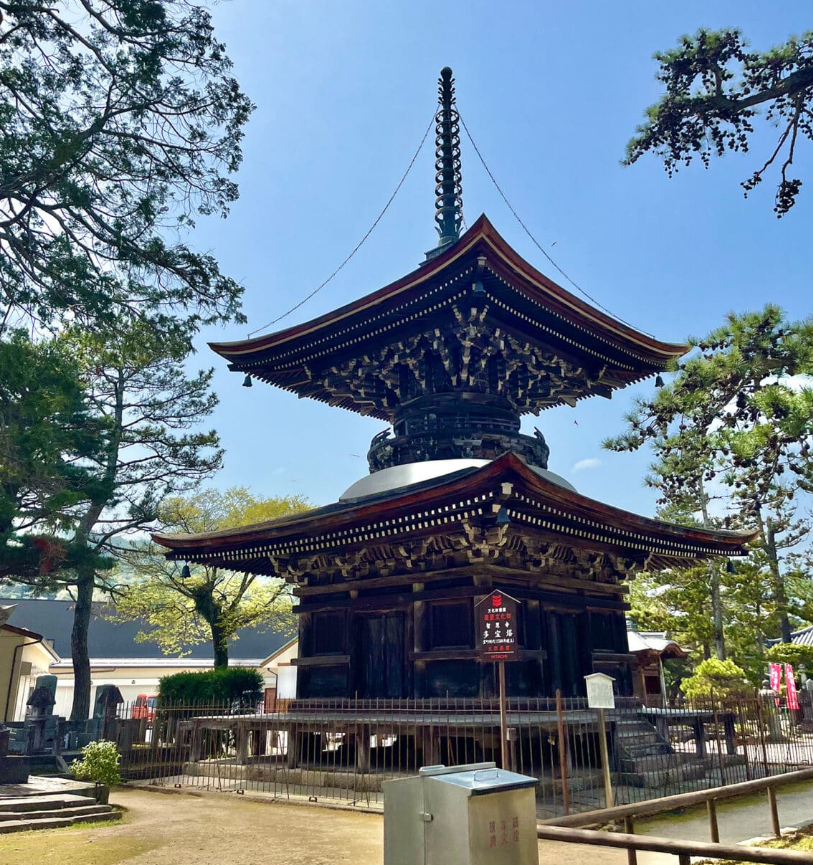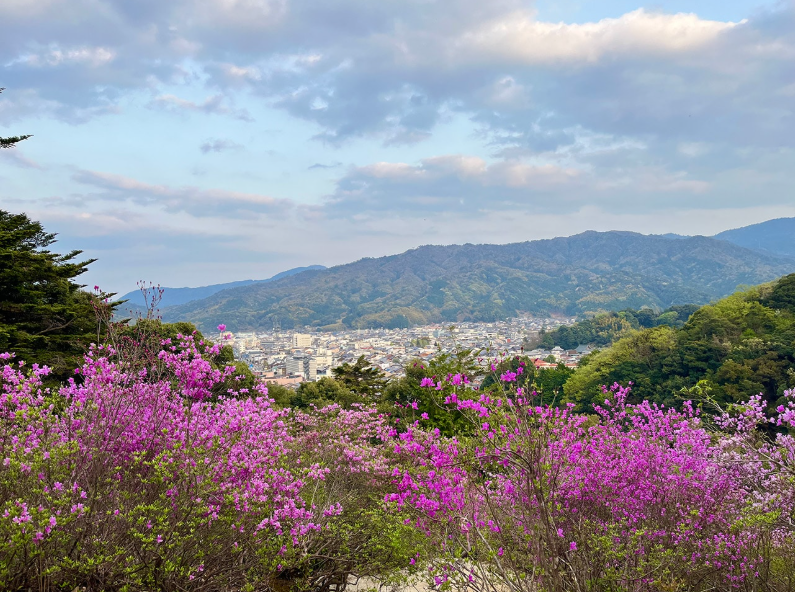Amanohashidate is a breathtaking 3.6km-long natural sandbar stretching across Miyazu Bay in northern Kyoto Prefecture. Known as Japan’s heavenly floating bridge, it is blanketed with pine trees and soft white sand, forming a tranquil lagoon called the Asoumi Sea.
Unlike other sandbars in Japan, Amanohashidate does not face the open sea directly. Instead, it was created by centuries of sediment carried in from Wakasa Bay, colliding with the currents from the Noda River. The result is one of Japan’s most iconic natural landscapes.

Recognised as a scenic wonder since the 8th century, Amanohashidate has been featured in many ancient Japanese texts and paintings, dating back to the 1400s.
Most notably in a large painting by master painter Sesshu Toyo, and as a woodblock print by Ukiyo-e legend Utagawa Hiroshige. In 1643, a Confucian scholar proclaimed Amanohashidate was one of the Three Views of Japan, cementing its place as a cultural treasure.
By 1873, the area was designated a quasi-national park, and eventually, an Important Cultural Landscape of the country in 2015.
Beyond its natural beauty, the region is famed for textiles and the silk crepe called Tango Chirimen, which is used for specialty kimonos. Fresh seafood is also abundant in the region and culinary traditions are just as rich. The local specialty includes chikuwa, a baked fishcake and a Chie no Mochi, a beloved rice cake that has delighted locals for generations.
Notable sights around Amanohashidate
Chionji Temple

The Chionji Temple is one of the three temples in Japan dedicated to the Monju Bodhisattva (the Bodhisattva of Wisdom). The temple grounds are near Mount Monju, and within them stands the striking Tahoto Pagoda, enshrines a statue of the Dainichi Nyorai, which believed to embody the buddha as a creator of all life.
At this temple, you can buy a fan-shaped fortune, tying them onto pine branches for good fortune.
Fun fact: The temple complex has also been designated a National Important Cultural Property of Japan.
- Chionji Temple, 466 Monju, Miyazu, Kyoto 626-0001
- Mon-Sun: 8am – 5pm
Three Views of Japan Monument

The 1600s was a time of relative peace and stability in Japan, and travelling for leisure became a popular pastime. It was no longer considered an activity reserved for aristocrats, monks, or wandering samurai.
In 1643, Hayashi Juho, a Confucian scholar, wrote that Amanohashidate was one of the Three (Great) Views of Japan. Many notable literary figures of the time also sung the praises of the region, making Amanohashidate a widely recognised locale in Japan. This eventually led to the protection and conservation of the region, as well as its promotion as a must-see destination.
- Three Views of Japan Monument, Monju, Miyazu, Kyoto 626-0001
- Mon-Sun: Always open
Hashidate Chaya

Nested on the Amanohashidate sandbar, this little teahouse is a great place to stop in for a quick lunch, or for an afternoon tea with matcha and wagashi (traditional Japanese sweets).
Lunch options include a range of soba and udon noodles, donburi rice bowls, and ochazuke (rice porridge). If you are leaning towards the sweet side, there are zenzai (a red bean soup with shiratama, or mochi rice balls, served hot or cold) or warabi mochi for your delight.
- Hashidate Chaya, Amanohashidate Park, Monju, Miyazu, Kyoto, 626-0001
- Mon-Sun (except Thursdays): 9.30am-5pm
The Amanohashidate Shrine

Believed to date back before the 1300s, the Amanohashidate Shrine is dedicated to Izanagi no Mikoto, the creator god in Shinto mythology. A natural freshwater spring behind the shrine adds to its sacred atmosphere. The temple grounds were last renovated in 1907, and the area remains maintained by Miyazu City to this day.
- Amanohashidate Shrine, 643-1 Monju, Miyazu, Kyoto 626-0001
- Mon-Sun: Always open
Asoumi-gawa Tori (Gates facing the Asoumi Sea)

There is a lone tori gate that faces the Asoumi Sea. The town across the bay is Yosano City, an agricultural suburb of Miyazu, which is also famous for silk production and textiles weaving, as for kimonos.
- Monju, Miyazu, Kyoto 626-0001
- Mon-Sun: Always open
Circular Stone Lanterns

While walking around Amanohashidate, you are bound to see these circular stone “lanterns”. Spot them atop observatory decks, at parks along the bay, and at prominent locales near the major shrines and temples in the region. This stone lantern is a local symbol, said to represent wisdom.
In the 1600s, a light was placed in the centre to summon the dragon god of Amanohashidate. Sometimes, coins can be found near the base of the stone circle, offered by people in the hopes of gleaning some supernatural wisdom.
Observation Decks
While there are 10 high places in the region that provide spectacular 360 views of the sandbar, here are some that are reasonably easy to access, and offer the best views!
Amanohashidate View Land

Just five minutes from Amanohashidate Station, Amanohashidate View Land is a small amusement park that doubles up as an observatory. Located at the top of Mount Monju on the Miyazu side, we suggest taking a chairlift or a monorail to enjoy the iconic Hiryukan (flying dragon view).
It is customary to view the sandbar upside down with your head between your legs, as the sandbar is supposed to look like a dragon, flying up towards the heavens.
The amusement park has a wide range of rides and activities such as archery, go-karts, carousels, and Ferris wheels for all ages to enjoy. If you want to catch a breath, there’s a restaurant, cafe and a souvenir shop.
- Monju, Miyazu, Kyoto 626-0001
- Mon-Sun: 9am-5pm (seasonal business hours)
- viewland.jp
Amanohashidate Kasamatsu Park

Across the sandbar on the Ogaki side, Kasamatsu Park offers stunning vistas from the observatory deck. Try your luck by tossing clay discs (kawarake) through a circular metal lantern for good luck.
Small shops here sell soft-serve ice cream, cold drinks and souvenirs. To get to Kasamatsu Park? Your best mode of transport is either the monorail or chairlift that takes you up and down the mountainside.
Tip: The return ticket of the monorail or chairlift doesn’t limit how you ride, and gives you the option to ride up with monorail and return on a chairlift down, or vice versa.
Bentenyama Observation Deck
A short bus ride from Kasamatsu Park leads to Nariaiji Temple, where you’ll find a five-storey pagoda and the Bentenyama observation deck. It’s an alternative bird’s eye view of Amanohashidate.
Tip: The bus ride from Kasamatsu Park is just two stops to Nariaiji Temple, approximately seven minutes.
- 339 Nariaiji, Miyazu, Kyoto 629-2241
- Mon-Sun: 8am-4.30pm
Mount Takigami Observation Deck

Close to Miyazu City centre, Takigami Park offers views of the city, the valley between Mount Takigami and Mount Mannen, and even glimpses of Amanohashidate. Springtime transforms the slopes into a sea of cherry blossoms and rhododendrons, while autumn ignites them in red and gold. A great spot for hikers.
- 371 Miyamachi, Miyazu, Kyoto 626-0008
- Mon-Sun: Always open
Getting around Amanohashidate
As the sandbar is mostly flat, the trail on the island consists of paved concrete sections, as well as natural trails made out of mostly sand and gravel. A walk across the entire length of the 3.6km sandbar takes around 40-50 minutes one way, though the sights will tempt you to linger.
Bicycle rentals
Bicycles are a great way to cover more ground while you are here and are the most popular option. There are numerous bicycle rental shops, some offering luggage storage or one-way rentals, so you can return the bicycle on the other end of the sandbar, giving you an option to take another form of transport, like a ferry or a sightseeing boat, back to Amanohashidate Station.
Ferry rides and sightseeing boats

There is a ferry terminal on either side of the sandbar offering one-way or return trips aboard sightseeing boats across the lagoon.
These catamarans have an open upper deck that offers panoramic views of the lagoon, the beautiful sandbar, and Yosano City, which sits across Amanohashidate from Ogaki. There is also an enclosed, air-conditioned lower deck, which has wide windows and comfortable seating.
Some of these sightseeing boats offer seabird feeding experiences for an additional fee, where snacks can be purchased along with your tickets. However, this is not generally recommended, as the snacks that are sold to feed the seabirds are rice crackers that are not a natural part of the seabirds’ typical diet.
Even so, during the ride, seagulls and hawks will approach the boat when they see people holding out the treats, and the braver birds will snag treats right out of your hands!
Cruises depart from Amanohashidate Pier (near Chionji Temple) to Ichinomiya Pier on the Miyazu side. Tickets are ¥800 one-way for adults, ¥400 for children under 12. On the Ogaki side, the Ichinomiya Pier also offers cruises back to Amanohashidate Pier at the same rate.
- 466 Monju, Miyazu, Kyoto 626-0001
- 118-1 Ogaki, Miyazu, Kyoto 629-2242
- Mon-Sun: 9am-5.45pm
- amano-hashidate.com
Go on a Side Quest and Visit Ine Bay’s Funaya

Just a short bus ride away lies Ine, a fishing village famous for its funaya, traditional boathouses that line the edge of the bay. Around 230 of these iconic structures stand along the waterfront, creating one of Japan’s most picturesque coastal scenes.
Historically, the ground floor was designed to shelter fishermen’s wooden boats and store nets, while the upper floor held equipment or occasionally served as simple living quarters.
Today, most boats are too large to fit inside, but the spaces are still used for drying fish or squid, cooking, or simply enjoying life by the water.
Few families actually live in their funaya full-time, though some upper floors house grandparents or adult children. To truly appreciate this unique way of life, take a 25‑minute sightseeing boat tour from Hide Pier, which glides past the funaya and offers a closer look at this centuries-old tradition.
- Hide Pier, 11 Hide, Ine, Yoza District, Kyoto 626-0425
- Mon-Sun: 9am-4.30pm
- ine-kankou.jp
Amanohashidate truly lives up to its name, a bridge to heaven. Whether you’re strolling under pine trees, gazing at the sandbar from a mountain observatory, or sipping matcha by the sea, this mystical stretch of land invites you to slow down and savour Kyoto’s northern coast.
[[nid:720873]]
This article was first published in City Nomads.
Top In Asia





